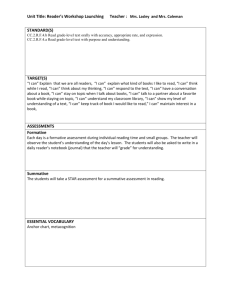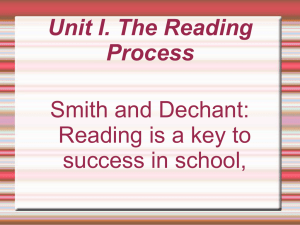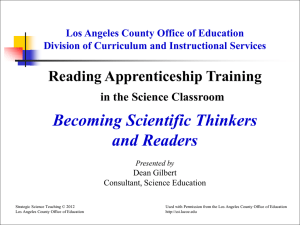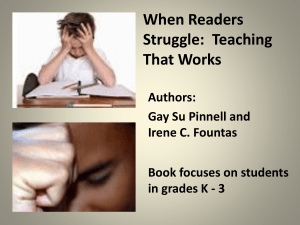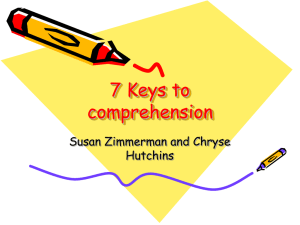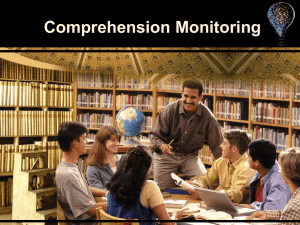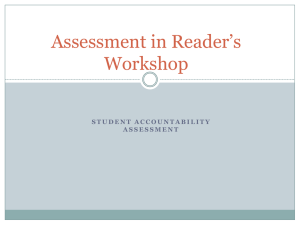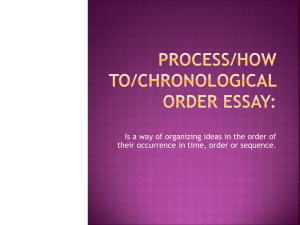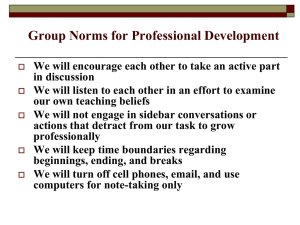RA powerpoint 2014
advertisement
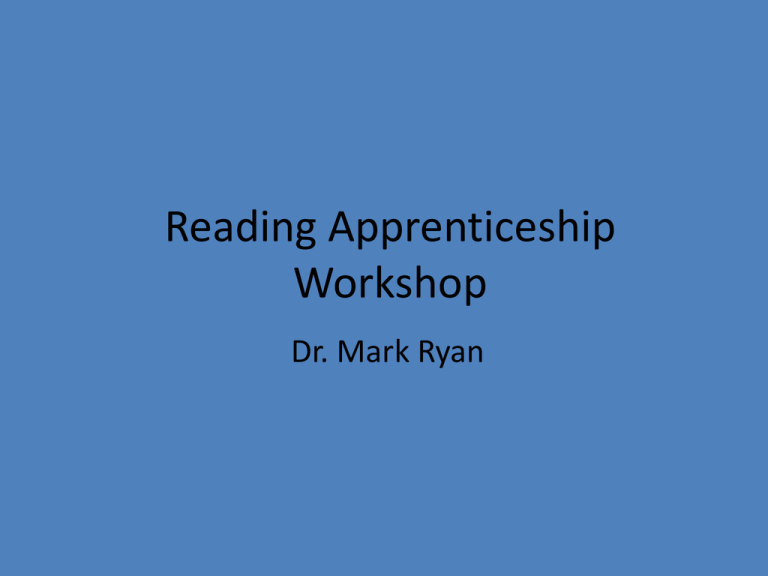
Reading Apprenticeship Workshop Dr. Mark Ryan What do you remember about your personal reading history? • • • • • • When did you learn to read? From whom? One person? Multiple people? Can you recall how that person or people taught you to read? Do you remember how you developed phonemic awareness? Do you remember how you developed reading fluency? Do you remember how you developed comprehension skills? True or False • After graduation, most students will choose to read a textbook on a daily basis. • 86% of daily adult reading is nonfiction. – Magazines, newspapers, applications, warranties, contracts, policy statements, manuals, consumer and workplace documents, ballots, menus, coupons, and Internet information. True or false • Students today read at about the same levels as students thirty years ago. • However, the literacy demands on our society have risen dramatically. True or False The California Department of Education looks at fourth-grade reading scores to determine how much money the state needs to allocate for building future prison space. • 90% of what is being read in America today is read by 10% of the population. As a high school teacher, you may be the students’ last chance to develop a level of proficiency that will enable them to fend for themselves, to avoid the oppression that often afflicts the uninformed in our society. Exploring the RA Framework What Reading Apprenticeship Is NOT . . . • A packaged program • Just one strategy • A once and done deal Reading Apprenticeship • RA is an approach to reading instruction that helps students develop the knowledge, strategies, and dispositions they need to become more powerful readers. • Partnership of Expertise Teacher knowledge of as Students’ unique strengths Disciplined-based readers As learners RA helps students become better readers by: • Engaging students in more reading • Making teachers’ discipline based reading processes visible to students • Making students’ reading processes, motivations, understandings, and strategies visible to the teacher • Helping students gain insights into their own reading processes • Helping students develop problem solving strategies to improve comprehension The Good Reader's Toolkit Dimensions of Reading Apprenticeship SOCIAL DIMENSION Creating safety Investigating relationships between literacy and power Sharing book talk Sharing reading processes, problems, and solutions Noticing and appropriating others' ways of reading COGNITIVE DIMENSION Getting the big picture Breaking it down Monitoring comprehension Using problem-solving strategies to assist and restore comprehension Setting reading purposes and adjusting reading processes PERSONAL DIMENSION Developing reader identity Developing metacognition Developing reader fluency and stamina Developing reader confidence and range Assessing performance and setting goals KNOWLEDGE-BUILDING DIMENSION Mobilizing and building knowledge structures (schemata) Developing content or topic knowledge Developing knowledge of word construction and vocabulary Developing knowledge and use of text structures Developing discipline- and discourse-specific knowledge Social Dimension • Creating Safety • Sharing Book Talk • Sharing Reading Processes, Problems, and Solutions • Noticing and Appropriating Others’ Ways of Reading Personal Dimension • Developing Reader Identity • Developing Metacognition • Developing Reader Fluency and Stamina • Developing Reader Confidence and Range Cognitive Dimension • • • • Getting the big picture Breaking it down Monitoring comprehension Using problem solving strategies to assist and restore comprehension • Setting reading purposes and adjusting reading processes Knowledge Dimension • Mobilizing and building knowledge structures (schema) • Developing content knowledge • Developing knowledge of word construction and vocabulary • Developing knowledge and use of text structures • Developing discipline and discourse specific knowledge RA Framework • 4 Dimensions – – – – Social Personal Cognitive Knowledge-Building • 2 Pillars –Metacognition –Extensive Reading Metacognition Thinking About Thinking Making Thinking Visible Metacognition Helps students understand that Reading happens in our minds And not on the page . . . Mapping the Metacognitive Conversation • • • • Noticing your thinking Focusing on reading Taking charge of reading Becoming aware of subject area discourse Reading Process Analysis A Think Aloud Is a way to Model the Complexities & Solutions of Reading Think Aloud • As a “Think Aloud” is modeled, pay attention to the “thinking” that the person is making visible. • Jot down a few strategies you see used. Schema Schema refers to the networks of concepts, beliefs, expectations, and information that is developed from our individual library of past experiences. The Knowledge we draw on: • • • • World Knowledge Text Knowledge Discipline Knowledge Language Knowledge When to Emphasize it? • Students need to activate and build schema at each stage of the reading process: as they prepare for and move INTO the reading experience, as they move THROUGH the reading, and as they move BEYOND the text, linking what they have read to other texts and ideas. Scaffolding: A strategic instructional support A scaffold provides enough help to allow the learner to accomplish the task at hand, but offers no more than is needed. Gradually decreasing support while gradually increasing the difficulty of the text and task. Reciprocal Teaching • RT is an instructional procedure designed to help struggling readers improve their reading comprehension through interactive dialogue. • Reciprocal Teaching provides opportunities in a socially supported environment for students to practice comprehension strategies good readers use to make meaning of text. • RT should be used for understanding not for learning discreet facts. RT ROLES • • • • • Discussion Leader/Facilitator Summarizer Questioner Clarifier Predictor A Way Of Questioning What We Read Question-Answer Relationship Just because you may struggle to read the text does not mean you can’t think about what you read. Many readers try to answer questions using ONLY information from the text. Other readers try to answer questions using ONLY their background knowledge. Three Levels of Text Processing • Literal – getting the facts as stated in a text. • Inferential – requires readers to determine an appropriate answer drawn from the text and what they already know. • Critical – requires readers to think beyond what is stated in the text. Readers draw information from their prior knowledge to come up with great answers. Question-Answer Relationships Right There – Text explicit Think & Search – Text implicit Author & Me – Text implicit/experienced based On My Own – experienced based Question-Answer Relationships Right There – The answer is directly stated in the text. In fact, the words from the question and the answer are included in the same sentence. I Love to Do My Homework I love to do my homework, it makes me feel so good. I love to do exactly as my teacher says I should. I love to do my homework, I never miss a day. I even love the men in white who are taking me away. What do I love to do? I Love to Do My Homework I love to do my homework, it makes me feel so good. I love to do exactly as my teacher says I should. I love to do my homework, I never miss a day. I even love the men in white who are taking me away. What do I love to do? My Homework Question-Answer Relationships Think & Search- The answer is in the text, but the words from the question and the answer are not in the same sentence. I Love to Do My Homework I love to do my homework, it makes me feel so good. I love to do exactly as my teacher says I should. I love to do my homework, I never miss a day. I even love the men in white who are taking me away. How do I feel when I do what my teacher says I should? I Love to Do My Homework I love to do my homework, it makes me feel so good. I love to do exactly as my teacher says I should. I love to do my homework, I never miss a day. I even love the men in white who are taking me away. How do I feel when I do what my teacher says I should? So good Question-Answer Relationships Author & Me- The answer is not in the text, but the text provides information to use in the answer. I Love to Do My Homework I love to do my homework, it makes me feel so good. I love to do exactly as my teacher says I should. I love to do my homework, I never miss a day. I even love the men in white who are taking me away. Where are they taking me? I Love to Do My Homework I love to do my homework, it makes me feel so good. I love to do exactly as my teacher says I should. I love to do my homework, I never miss a day. I even love the men in white who are taking me away. Where are they taking me? Hospital, Mental facility, etc. (answer must make sense and be supported by the text) Question-Answer Relationships On My Own- The answer is not in the text; it must come from the reader’s own experiences. I Love to Do My Homework I love to do my homework, it makes me feel so good. I love to do exactly as my teacher says I should. I love to do my homework, I never miss a day. I even love the men in white who are taking me away. Why is homework an important part of school? I Love to Do My Homework I love to do my homework, it makes me feel so good. I love to do exactly as my teacher says I should. I love to do my homework, I never miss a day. I even love the men in white who are taking me away. Why is homework an important part of school? It helps you learn new concepts, Gives the teacher an idea of how well you understand the concept, etc. Jerry picked up his bat, ball, and his glove. He went to the playing field. Some boys were already hitting and catching fly ball. 1. What did Jerry pick up? 2. Where did Jerry go? 3. What game is Jerry going to play? 4. What is your favorite game? How can this strategy be used to study new material? • Read the material thoroughly. •Determine the main idea(s) you want to know. • Develop questions from all four levels. • Reread the material and complete the study guide in order to ensure correct question levels. Talking to the Text Writing down your thoughts, questions, visualizations, connections, etc. as you read. • • Think aloud on paper • A written record of your thoughts as readings. Advantages of Talking to the Text •Allows students to feel safer and better prepared to discuss texts •Allows time to analyze personal reading processes •Allows students to choose which comments to share •Leaves an enduring record of the students’ thinking Tips for Talking to the Text • Be sure to have plenty of “white space” in which to have students write. • When copying is an issue, try using post it notes. • Try using “pre-written” post it notes to save students from writing repeated comments. • Try folding a piece of paper lengthwise for students to place next to the text with their comments. • Set expectations for a variety and quantity of questions and comments. • Allow yourself the luxury of taking time – It does take time for the students to use TttT initially. Before Reading • Before students read a piece of text, they should… – preview it to determine what type of text they will be reading (fiction, non-fiction, poem, news article, etc.). – examine the title for any clues it may give. – look at pictures, captions, headlines, and words that jump out at them. – make predictions regarding what the text will be about. During Reading • As students are reading, they should make notations about: – any questions they have about the text. – comments they have about the piece. – any unfamiliar words and try to figure out their meanings using context clues. – what they wonder about while they read. – what confuses them as they read. During Reading (cont.) • As students are reading, they should make notations about: – anything that reminds them of another text, their personal experiences, or how these connections help them to understand the text. – words, phrases, or sentences they find interesting. – big ideas that seem important to the text as a whole. – summary thoughts that capture the author’s main point. – any inferences or predictions made from clues in the text. After Reading • Once students have finished talking to their texts, … – they can discuss their notes/findings/questions in small groups first. This will allow classmates to help one another figure out word meanings, answer questions, and make connections. – Then, bring the whole class together to continue and eventually wrap up this discussion. – Students can also orally summarize the text or write their summaries down. Word Walls Key academic vocabulary Consider such things as… -etymology -word in a sentence -definition in own words -picture/image to help remember the meaning Once up, they stay up for the year and are referenced in class discussions and activities Sentence Frames THIEVES
